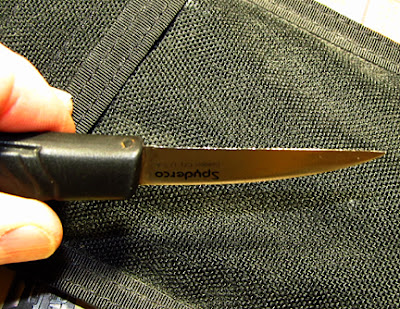The first day of the Blade Show came off without a hitch, at
least from my perspective. By the end of
the day I got a lead on a new article for Knife Magazine, and found out my
Benchmade article will be published in the July issue, so that’s all good.
I purchased a tactical tomahawk from the Australian company
Hardcore. Since the story from 9/11 of
the window washer who battered his way through a plaster wall to save himself,
I’ve been wondering what I would do.
This is even more significant because of work. In the almost five years I’ve been there,
they have never had a fire drill and when I asked about where my department
meets for a head count following a disaster, nobody seemed to know. I think self rescue should be my middle name.
We lined up about 10 o’clock for the opening at noon. Two guys (women have more sense) lined up at
midnight the previous night to be the first in.
Men 3 and 4, it was reported, lined up at 2am.
What was the rush?
There are many answers. Microtech
has some very good deals on autos you could cash in on if you got a couple thousand
set aside. Same with Busse. They have a huge following. There are quite a few custom knife dealers
with high end prices and only a few knives to sell.
 |
| I could not get to see any Microtech knives, the line to buy was too thick. |
Many of these knives will re-emerge on the resale market in
a few days. The prices will be higher
and many will disappear quickly. It’s
hard to believe the following some knife companies have.
At noon they started letting us in the main door. You had to have either a VIP pass or pay an
additional $20 to get in early. We had
passes.
Shadow Tech has released their first folder. Right now they are all made by hand and have
an interesting construction. John wanted
special components togive it more strength and improve on its performance and he’s
got a pretty nice knife. I expect a few
modifications over time; nothing is made perfect the first time. His karambits are very interesting. The large handle maybe bigger than many other
manufacturers, but it feels solid and locks open when you hold it. John and Dave have designed several
interesting ways of snapping them open during the draw.
 |
| The new Shadow Tech folders |
I was disappointed by CRKT last year. What a difference one year has made. They have some very exciting new knives which
should be reaching the market soon. CRKT
always over-engineers their knives and I didn’t see any change in that. This could be the year you should buy a CRKT.
I stopped off at a new company called James. They have two ‘gentleman’ knives they are
offering. The lines are very modern and
the knives are very nice. The name
reflects their belief that this is the style knife Ian Fleming’s Bond (not the
movie ones) would carry in the casinos at Monte Carlo. They are design engineers and not machinists,
so it’s been an interesting adventure for the two of them.
 |
| James Folders |
We stopped long enough to see one knife from Popl Custom. It was quite lovely and a table auction starts
at $5000. That’s dollars, in case you were
confused. I didn’t even touch it to get
a better picture.
 |
| It is a crappy picture, but I was afraid I touch it and the handle would fall off, I'm not buying that thing! |
No Blade Show is complete without demos and classes. I sat in on one by Abe Elias on machetes as
bush knives. While I’m not ready to rush
out and buy one (I already have one in the basement) it’s amazing what you can
do with one. Abe talked about proper
cutting, safety and showed techniques to accomplish many of the basic cutting
techniques. It was well worth the hour.
I also paused long enough to watch a short demo of knife
grinding with a Burr King grinder. It
was like the 4th of July as it shot sparks everywhere. The really impressive thing is how smoothly the
demonstrator moved the knife grinding the edge.






















